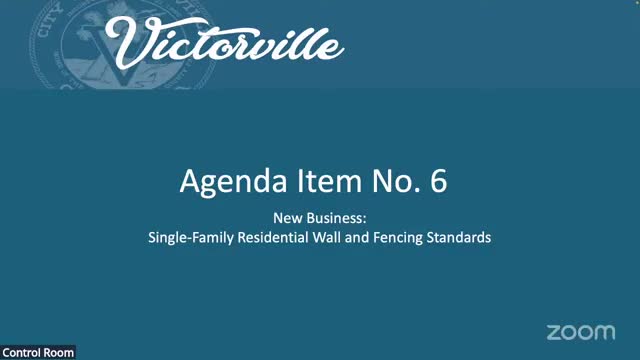Victorville planning commission declines vinyl-fence pilot, cites fire, durability and community concerns
October 09, 2025 | Victorville City, San Bernardino County, California
This article was created by AI summarizing key points discussed. AI makes mistakes, so for full details and context, please refer to the video of the full meeting. Please report any errors so we can fix them. Report an error »

The Victorville Planning Commission voted unanimously to take no action on a proposed amendment that would have allowed vinyl fencing as an alternative to the city's standard masonry block walls in new tract home developments. The commission's decision leaves the current masonry-only standard in place.
Staff told the commission that the city's single-family design guidelines and development code prioritize long-term public safety, durability and neighborhood character, and that vinyl fencing would not meet those objectives. "The current masonry block wall standard directly supports the development code's mandates for public safety, high design quality and enhanced community character," staff presenter said during the discussion.
The item drew several public comments in favor of permitting limited vinyl fencing. Carlos Rodriguez of the Building Industry Association of Southern California asked commissioners to adopt a resolution to begin a municipal code amendment process and to limit vinyl to side and rear yards inside tract boundaries. "We respectfully urge your vote of support for option B," Rodriguez said. Builder representatives and community developers argued vinyl can reduce construction costs and help affordability, saying the product is widely used across Southern California and carries warranties and engineered wind ratings.
Fire and building officials told the commission the safety picture is more complex. Deputy Fire Chief Andrew Roach cited research and full-scale tests showing combustible fences, including polyvinyl chloride systems, can act as a pathway for flame spread in wind-driven wildfire conditions. "From the fire department perspective ... combustible fences, including vinyl, act as fuses," Roach said, adding that masonry walls are noncombustible and better protect adjacent structures. City Building Official Joe Slager noted masonry walls typically provide far greater resistance to wind and fire and observed that recent state mapping places more parts of the city into moderate and high fire severity zones.
Code compliance staff and animal services also reported a higher volume of enforcement and neighbor-dispute complaints tied to nonmasonry fences. George Duran, code compliance official, said patch repairs and shifting panels commonly create recurring complaints and civil disputes that masonry walls largely avoid.
Commissioners acknowledged concerns about construction costs and affordability raised by applicants, but said the safety, longevity and neighborhood character arguments carried greater weight. Commissioner remarks noted extensive prior public workshops used to craft the single-family design guidelines and that AB 130 and other state developments create legal ambiguities that could extend any temporary change well beyond an intended pilot period.
Vote at the meeting was unanimous: the commission adopted option A, to keep existing standards and not initiate a municipal code amendment to allow vinyl fencing in new tract developments.
Staff told the commission that the city's single-family design guidelines and development code prioritize long-term public safety, durability and neighborhood character, and that vinyl fencing would not meet those objectives. "The current masonry block wall standard directly supports the development code's mandates for public safety, high design quality and enhanced community character," staff presenter said during the discussion.
The item drew several public comments in favor of permitting limited vinyl fencing. Carlos Rodriguez of the Building Industry Association of Southern California asked commissioners to adopt a resolution to begin a municipal code amendment process and to limit vinyl to side and rear yards inside tract boundaries. "We respectfully urge your vote of support for option B," Rodriguez said. Builder representatives and community developers argued vinyl can reduce construction costs and help affordability, saying the product is widely used across Southern California and carries warranties and engineered wind ratings.
Fire and building officials told the commission the safety picture is more complex. Deputy Fire Chief Andrew Roach cited research and full-scale tests showing combustible fences, including polyvinyl chloride systems, can act as a pathway for flame spread in wind-driven wildfire conditions. "From the fire department perspective ... combustible fences, including vinyl, act as fuses," Roach said, adding that masonry walls are noncombustible and better protect adjacent structures. City Building Official Joe Slager noted masonry walls typically provide far greater resistance to wind and fire and observed that recent state mapping places more parts of the city into moderate and high fire severity zones.
Code compliance staff and animal services also reported a higher volume of enforcement and neighbor-dispute complaints tied to nonmasonry fences. George Duran, code compliance official, said patch repairs and shifting panels commonly create recurring complaints and civil disputes that masonry walls largely avoid.
Commissioners acknowledged concerns about construction costs and affordability raised by applicants, but said the safety, longevity and neighborhood character arguments carried greater weight. Commissioner remarks noted extensive prior public workshops used to craft the single-family design guidelines and that AB 130 and other state developments create legal ambiguities that could extend any temporary change well beyond an intended pilot period.
Vote at the meeting was unanimous: the commission adopted option A, to keep existing standards and not initiate a municipal code amendment to allow vinyl fencing in new tract developments.
View full meeting
This article is based on a recent meeting—watch the full video and explore the complete transcript for deeper insights into the discussion.
View full meeting
